| |
Over 300 new gas-fired power plants are planned for the U.S. in at least 45 states. Is your state one of them? They'd be worse for the climate than the coal power plants they'd largely replace and will drive up the demand for fracking.
Why aren't we hearing more about this? Honestly, it's largely because big environmental groups (and their funders) have accepted the switch from coal to gas, even though the science tells us that this will doom us with more extreme climate change.
We started Energy Justice Network in 1999 with the purpose to help people fight gas-fired power plants. That was before fracking put gas in the "dirty" column for many people. It wasn't easy. However, grassroots resistance helped kill at least 60% of an estimated 1,000 power plant proposals at the time. The 400 that slipped through caused the electricity sector to grow to be the largest source of gas consumption. With a new wave of gas power plants proposed, we must focus on them once again if we want to blunt the demand for fracking, mitigate global warming, and save our communities that are threatened by the power plants, pipelines, compressor stations and related infrastructure.
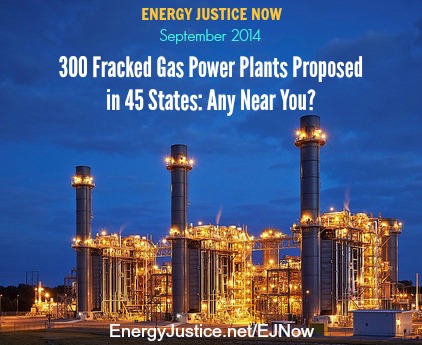
Why We Must Fight Natural Gas Power Plants
- by Mike Ewall, Energy Justice Network
The Ban Ki Moon U.N. Climate Summit is shortly coming to New York City. As we march and teach workshops at climate convergences, the media is likely to focus on the story of the Obama administration’s “Clean Power Plan” moving us away from coal in order to mitigate climate change. The story won’t be told that this plan will do more harm than good, mainly by ignoring methane and enabling a huge move from coal to gas-fired power plants.
The plan also does more harm than good by not regulating CO2 from trash incineration (2.5 times as bad as coal for the climate) and biomass incineration (50% worse), thus encouraging a large-scale conversion to burning everything from trash to trees. Other EPA deregulation efforts allowing waste burning to escape regulation by calling waste a “fuel” are also clearing the way for this toxic, climate-cooking disaster.
A leading researcher for a major fracking corporation recently confided in me that this move from coal to gas will spell disaster for climate change, confirming that if only about 3% of the gas escapes, it’s as bad as burning coal. Actual leakage rates are far higher (4-9% just at the fracking fields and more in pipelines and distribution systems), but it was most interesting to hear this person admit that the industry will never get below that level of leakage to become less harmful than coal.
We now know that methane is 86 to 105 times as potent as CO2 over a 20-year time-frame -- we’re in real trouble if we keep using the outdated “20 times over 100 years” figure EPA maintains, and permit this new generation of gas-burning to be built.
Why is it strategic to focus on the power plants? Read on…
READ MORE/COMMENT
Standing with Communities in the Shalefields
- by Energy Justice Summer
This summer, youth gathered in the shale gas region of Northeastern Pennsylvania to facilitate trainings, compile reports, and to fight for the safety of landowners, workers, and the environment. Energy Justice Summer is based in Susquehanna County in order to directly connect with the community members impacted by shale gas development.
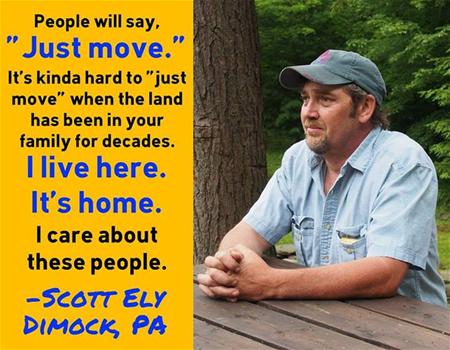
Charlotte Lewis, a research team member, Scranton native and student at Lackawanna College said, “Rural communities in Pennsylvania are changing from farmland to gas land. When this source of energy is depleted, what industry will we have left to sustain us?” Lewis and her team members have drafted a socioeconomic impact report focusing on poverty indicators and the decline of farm-related income in rural counties with high-volume drilling.
Sarita Farnelli, education and outreach team member, and a student who grew up in Dimock, PA said, “Fracking made my family's water undrinkable. I'm still afraid to drink our tap water.”
READ MORE/COMMENT
What the Frack? Scraping the Bottom of the Oil Barrel
- by Mark Robinowitz, PeakChoice.org
The toxic impacts of hydraulic fracturing for oil and gas have been subject to public debates, protests, and lawsuits, among other tactics to stop these dangers. But the other half of the fracking story, which has had much less attention, is the exaggeration of recoverable reserves.
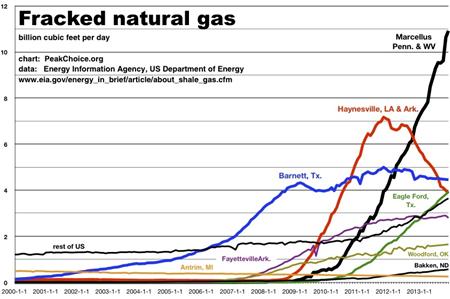
The fracking industry claims shale gas will fuel 100 years worth of USA consumption of “natural” gas. Massive amounts of drilling in the past several years have increased gas production above the 1973 natural gas peak. Gas has significantly increased its share of the electric power grids, lowering coal combustion and helping damper plans for new nuclear reactors.
Two of the three top gas fracking regions in the USA have peaked. Barnett Shale near Fort Worth, Texas has peaked and plateaued. Haynesville in Louisiana and Arkansas has peaked and declined sharply. The largest fracking region -- Marcellus in Pennsylvania -- has not yet peaked and provides nearly a fifth of all USA natural gas. Nationally, about forty percent of natural gas is from fracking.
Fracking for oil has reversed the decline of USA oil extraction since the 1970 peak. The Bakken shale in North Dakota has fueled wild claims of alleged energy independence and even proposals to export oil to Asia. However, Bakken has not even offset the decline of the Alaska Pipeline, which has dropped three fourths from its 1988 peak and is approaching “low flow” shutdown. Fracking in south Texas has also raised Texan oil production but the state’s peak was still back in 1972 -- a reason huge efforts have been made for offshore drilling in the Gulf of Mexico.
Post Carbon Institute has published reports documenting how fracking estimates have been exaggerated. They were vindicated in May of this year when the Department of Energy admitted plans for oil fracking in the Monterey Shale in California had been exaggerated and downsized the estimated resource by ninety-six percent (96%).
READ MORE/COMMENT
Energy Justice Now provides critical reporting on the entire spectrum of the Dirty Energy Resistance, highlighting the voices of community organizers
battling fossil fuels, nuclear power, and biomass and waste incineration
from sea to shining sea. We are accepting submissions at Josh AT energyjustice.net.
Cover photo by: Duke Energy
In Solidarity,
Mike Ewall, Josh Schlossberg, and Samantha Chirillo
Editors, Energy Justice Now
Donate here (please & thanks!): http://www.energyjustice.net/donate
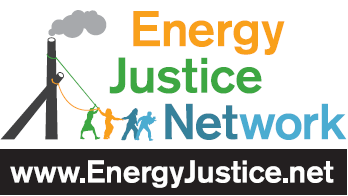
Logo by Alex Zahradnik Design
|
|
|
TAKE ACTION!
Gas Power Plant Organizer's Call

On Tuesday, October 7 at 4 pm PST / 7 pm EST, join anti-fracking activists from across the U.S. on an historic organizing call in an effort to unite the national movement to oppose 300 new natural gas power plant proposals across 45 states.
Take this opportunity to network, strategize, and build coast to coast solidarity!
Email Mike AT energyjustice.net for the conference call number and password. Hope to hear you on the call!
Can't make it? Be in touch, anyway, so we can plug you into this new network!
ACTIVIST TOOLKIT
Gas Power Plant Map

The Energy Justice Communities Map keeps track of all the existing, proposed, and defeated dirty energy and waste facilities in the U.S. in order to build a network of community groups to fight the facilities and the corporations behind them.
Due to the recent explosion of hydraulic fracturing, 300 natural gas-fired power plants are proposed across 45 states, which you can find here.
To oppose a facility, sign up for the EJ communities Map and enter the name of your community group and we'll contact you to provide you with any help you need to fight the facility in your town.
INFOSHOP

Check out these links below to get up to speed on the perils of fracking and why the concept of natural gas as a "bridge" fuel to renewable energy is deeply flawed.
Natural Gas Factsheet
Energy Justice Network lays down the basics about natural gas
Frack University
This project of Energy Justice Network trains organizers to assist communities fighting fracking
Know Your Driller: Shell
A report investigating violations by Shell Oil Co. in the shale fields
Methane Leakage from Natural Gas
Info demonstrating climate impacts from natural gas
Gas Pipelines
Learn a bit about pipelines
Coal Bed Methane
An intro to coal bed methane
Gas Not a Transition Fuel
Debunking the concept of "transition" or "bridge" fuels
Un-naturalgas.org
Home of the statewide ban on hydrofracking in New York
MontereyOil.org
Drilling California: a reality check on the Monterey Shale
Physicians, Scientists, & Engineers for Healthy Energy
Objective, evidence-based information
PostCarbon.org
Leading the transition to a more resilient, equitable, and sustainable world
RichardHeinberg.com
Peak oil prophet and author of the End of Growth
PeakChoice.org
Cooperation or Collapse?
GET INVOLVED
Energy Justice Network Email Lists
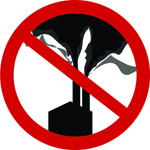
Energy Justice Network hosts an email list focused on stopping fracking and the construction of new natural gas power plants in the U.S., with over 150 organizers from across the country.
Keep your fingers on the pulse of what's going on in the movement while strategizing and networking with fellow organizers.
To sign up for the Natural Gas list, send an email to Mike AT
energyjustice.net, introducing yourself and your work and we’ll be in touch!
|
|


